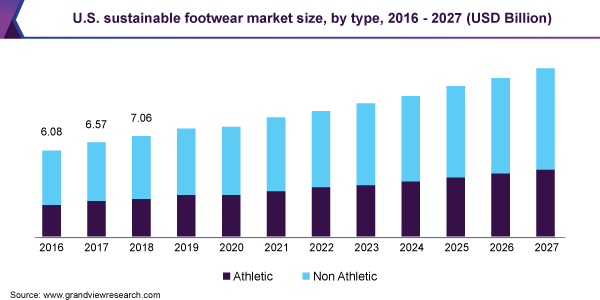The global sustainable footwear market size was valued at USD 7.5 billion in 2019 and is expected to grow at a compound annual growth rate (CAGR) of 5.8% from 2020 to 2027. The market growth is attributed to advancements in the sustainable space, along with material processing technology and functionality. This market for sustainable footwear is poised to witness significant growth in the near future owing to several factors. Growing awareness among consumers is a key factor prompting the manufacturers to innovate their product offerings. Rising number of youngsters globally, coupled with significant purchasing power of this consumer group, is likely to favor market growth over the forecast period. Source:https://www.grandviewresearch.com/industry-analysis/sustainable-footwear-market
The footwear industry is constantly evolving and observing consumer patterns and activities over the years. In this regard, the on-the-go lifestyle among millennials has been encouraging manufacturers to increase their scale of production, most notably in the sneaker category. According to the NDP Group, consumers demand versatility, comfort, functionality, sustainability, and performance in a variety of settings. This factor has been leading to brands embracing social and eco-consciousness in their innovative sustainable footwear manufacturing.
Sustainability has been observed to be a key trend over the years. On this front, many experts believe that innovations in production will continue to gather momentum. Many prominent market participants, including Nike and Adidas contributed to the sustainable methods of production, such as reduced labor cost and wastage. Digitization also allows to create sample footwear with better materials and use of 3-D printer for predicting a single shoe in multiple forms, patterns, and colors.
Lengthy production process is one of the key challenges faced by the market for sustainable footwear. A sustainable footwear typically contains materials that are inseparable and decomposable, yet it uses harmful chemicals during the process. The raw materials required to manufacture sustainable footwear are more expensive than the raw materials used in the production of conventional footwear. However, technological advancements in terms of recycling fabrics more efficiently are likely to reduce the cost of procuring raw materials in the foreseeable future.
Recycling is expected to remain the operative word within the sustainable footwear industry in the near future. For instance, in April 2019, Adidas launched its fully recyclable Futurecraft Loop Sneaker line featuring a carbon neutral style. This innovation was targeted atGenZ and Millennials who are aware about the concept of sustainability and prioritize it more than the previous generations. Rothy’s produced shoes from recycled plastic bottles in 2016 and now it is valued at $700 million.
